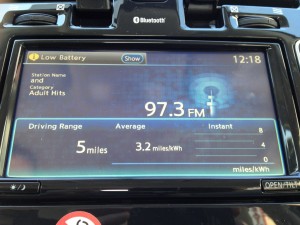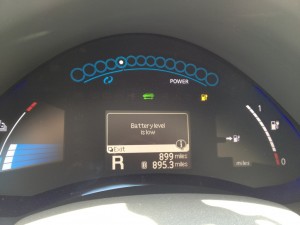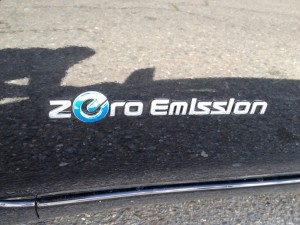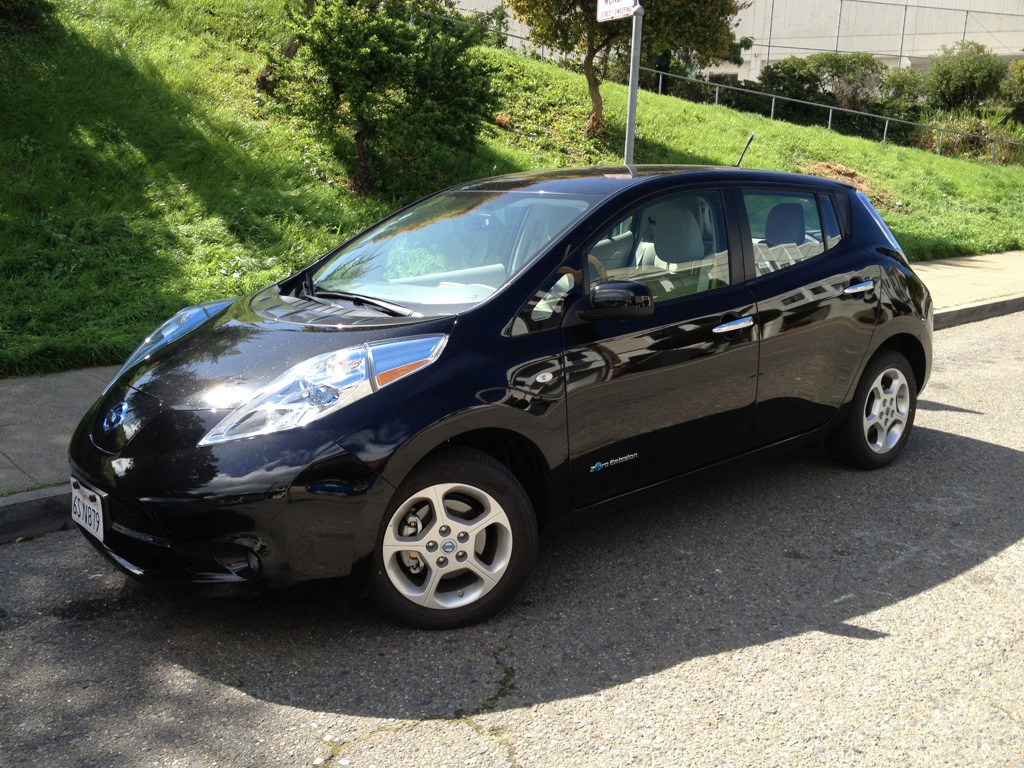I Sing the Vehicle Electric: 24 Hours With a Nissan Leaf
Growing up in the energy-crisis late-1970s, oil has always been for me the subject of fascination — and occasional derision. No commodity has, I think, been so central or so fraught. Its energy density, its uncertain availability, its volatile price… no other natural resource makes front-page headlines the way it does (when was the last time anyone cared about the price of, say, phosphorus or magnesium?)
The question that’s been burning me up (pun sort-of intended) since kidhood is: when are we finally going to get off the stuff? It continues to amaze me, what with more solar energy striking the Earth in an hour than humankind uses in a year, and with Einstein’s e=mc2 equation long since having found practical application in nuclear energy (and more destructive forms of same).
Oh, I know, the reasons are legion, from the realities of legacy energy infrastructure to facts about energy density to what I believe is a plain-old failure of the imagination. I recently got into a near-argument with a colleague from conservative Georgia who claimed that alternative-energy research is bunk, and all these newfangled vehicles are doomed to failure. After he promulgated the usual Fox News canards (“none of this will work without subsidies”, “it’s just shifting pollution to the electrical grid”, etc.), I finally blurted out, “Come on; we’re scientists. We’re not supposed to thrown up our hands and say ‘impossible!'”
So to that end, when the time came for me to pick up a rental car for a day’s worth of errands and a visit to some friends down the Peninsula, I responded with an enthusiastic “yes, please!” when the agent at the car-rental shop asked, “do you want to try the new Nissan Leaf?”
 I was a bit concerned about the oldest bugaboo in the book: although I’d heard electric cars are a pleasure to drive (responsive, power-efficient engines), the limiting factor for them has always been energy storage. While gasoline, for all its faults, can store an incredible amount of energy (and is easily portable, being a liquid at room temperature), battery technology has always been comparably weak. That’s why batteries typically only power small devices, why they’re constantly running down and needing to be recharged or replaced… and why, in spite of a heritage going back to the earliest days of the automobile, they never caught on the way their petroleum-distillate counterparts did. Only now, with historic rises in oil prices and talk of peak oil — coupled with incremental advances in battery efficiency — are electric cars starting to come out in greater (though still modest) numbers. So much so that my local Enterprise outlet now offers them as part of their regular fleet.
I was a bit concerned about the oldest bugaboo in the book: although I’d heard electric cars are a pleasure to drive (responsive, power-efficient engines), the limiting factor for them has always been energy storage. While gasoline, for all its faults, can store an incredible amount of energy (and is easily portable, being a liquid at room temperature), battery technology has always been comparably weak. That’s why batteries typically only power small devices, why they’re constantly running down and needing to be recharged or replaced… and why, in spite of a heritage going back to the earliest days of the automobile, they never caught on the way their petroleum-distillate counterparts did. Only now, with historic rises in oil prices and talk of peak oil — coupled with incremental advances in battery efficiency — are electric cars starting to come out in greater (though still modest) numbers. So much so that my local Enterprise outlet now offers them as part of their regular fleet.
“You can definitely make it to Menlo Park and back,” said the agent as he sat me down in the car and gave me a tour of its Internet-age instrument cluster. “Just make sure to put it in ‘Eco mode.” Apparently in this mode the vehicle uses less energy, sacrificing a bit of performance to do so.
Right away it was apparent that the boosters of electric-drivetrain vehicles were right: the car drives fantastically. Even in Eco mode it was smooth, zippy, and (of course) quiet. The range indicator ticked off the miles remaining at a slightly slower pace than actual miles driven. Since the car is all-electric, it’s able to recapture some of the energy lost in braking to charge the battery, a process known as regenerative braking. The car’s initial range was 80 miles (a bit more with Eco mode on); after half a day’s worth of errands, I still had some 70-plus miles left — more than enough for the 28 or so miles each way to get down to my friends’ party in the Peninsula that evening.
Still, I wanted to see if I could top up, and to that end went looking for one of those electric vehicle charging stations the eco-minded leadership in San Francisco has been busily installing these past few years. A few taps on my smartphone and I found one nearby — in the parking garage of a nearby Costco superstore.
Easier said than done, however: no signage existed inside the mammoth parking area, and only care of an employee did I discover the two spots, forlornly tucked away behind the exit and a tire service center. Both were available free of charge, and both had charging receptacles… but neither one of them featured the type of outlet my Nissan Leaf called for.
 Still, I figured I’d be fine, and with a friend in tow I headed down south. Again, even in Eco mode the car was as assured on the highway as any comparable subcompact… but neither of us could help turning our eyes toward the range meter: the miles kept peeling off as we cruised at typical highway speeds (in these parts they nudge 70 mph). Our 30 miles of distance consumed 45 miles of charge… which means we were down to 25 miles and wouldn’t have enough to get home.
Still, I figured I’d be fine, and with a friend in tow I headed down south. Again, even in Eco mode the car was as assured on the highway as any comparable subcompact… but neither of us could help turning our eyes toward the range meter: the miles kept peeling off as we cruised at typical highway speeds (in these parts they nudge 70 mph). Our 30 miles of distance consumed 45 miles of charge… which means we were down to 25 miles and wouldn’t have enough to get home.
Fortunately, my suburban friends have a garage (and a long three-pronged extension cord), and with the car’s own cord and adapter, we plugged the thing in and settled in for some St. Paddy’s Day revelry. Five hours later, the charge was up to 45 miles… which based on previous consumption patterns would barely be enough to get back to San Francisco. As it happens, SFO airport (and another Enterprise outlet) was on the way, so I figured if we were running low on juice stopping there to swap vehicles was always an option.
This time, however, I really took it easy (I am, admittedly, a bit of a leadfoot): we turned off the climate control, and drove a grandpa-style 55 mph the whole way home. This time the mileage corresponded more closely to the range meter, and we got back with over a half-dozen miles to spare. This was more than enough to head back to the rental place the next morning, where I experienced the best part of the whole adventure: no need to fill up!
 So what’s the verdict? I think this is a stellar step in the right direction, but a combination of improved battery range and recharging infrastructure need to be in place to truly make this viable. This has been the chicken-and-egg issue with electric vehicles all along: the expense of getting everything in place is staggering. Sure, this was true back in the early 20th-century with gasoline vehicles as well, but the difference then was that no motor vehicle infrastructure existed, so any improvement in fueling and roadways were welcomed (and took a long time, too: from the invention of the motorcar in the 1880s to widespread popularity in the 1920s marks a span of nearly half a century). But now we already have an infrastructure in place, a gasoline-based system, and turfing out that “legacy” investment is proving a tough nut to crack. And until there is a reliable electric infrastructure in place, people are understandably gun-shy about plunking down their ducats… and so continues the vicious cycle.
So what’s the verdict? I think this is a stellar step in the right direction, but a combination of improved battery range and recharging infrastructure need to be in place to truly make this viable. This has been the chicken-and-egg issue with electric vehicles all along: the expense of getting everything in place is staggering. Sure, this was true back in the early 20th-century with gasoline vehicles as well, but the difference then was that no motor vehicle infrastructure existed, so any improvement in fueling and roadways were welcomed (and took a long time, too: from the invention of the motorcar in the 1880s to widespread popularity in the 1920s marks a span of nearly half a century). But now we already have an infrastructure in place, a gasoline-based system, and turfing out that “legacy” investment is proving a tough nut to crack. And until there is a reliable electric infrastructure in place, people are understandably gun-shy about plunking down their ducats… and so continues the vicious cycle.
There are a number of ways out of this: for one thing, a “hot-swappable” battery would be great. At least one company is working on this. A global, universal standard would be nice as well — I shouldn’t have had an issue finding charging stations compatible with my model of vehicle. And improved battery life (and an accurately-rendered one at that) is critical: until cars can get 300-plus miles to a charge, I doubt many of us will be interested (one manufacturer is pretty close to that benchmark already). Sure, having a “city car” is nice, but for most of us, the ability to go anywhere, anytime, is what we pay to have an automobile for. As with all things environmental, it’ll only be when green technologies offer comparable features to their non-green counterparts that they’ll really become popular.
Ultimately, then, I think this is going to take a coordinated, concerted effort on the part of governments, corporations, and the public — a notoriously difficult combination to get in sync. But similar such efforts have been successful in the past, from winning World Wars to putting men on the moon. In spite of initial hurdles, I’m excited to see what comes next — and will definitely be first in line when this technology is more mature.






